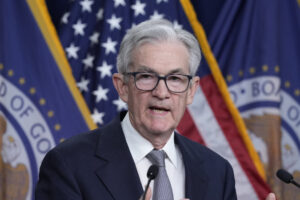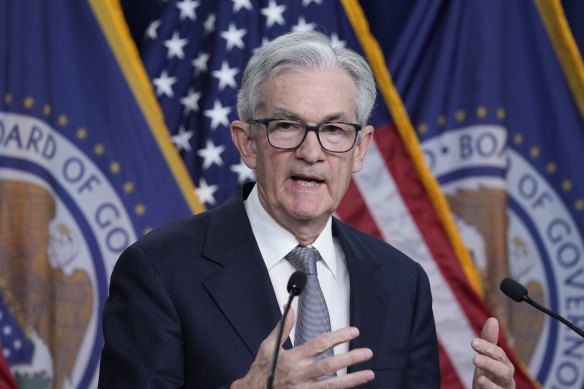Federal Reserve stays on hold but eyes three cuts next year; markets jump

Save articles for later
Add articles to your saved list and come back to them any time.
The Federal Reserve kept its key interest rate unchanged Wednesday for a third straight time, a sign that it is likely done raising rates after having imposed the fastest string of increases in four decades to fight painfully high inflation.
The Fed’s policymakers also signalled that they expect to make three quarter-point cuts to their benchmark interest rate next year, fewer than the five envisioned by financial markets and some economists. The relatively few number of rate cuts forecast for 2024 — which may not begin until the second half of the year — suggest that the officials think high borrowing rates will still be needed for most of next year to further slow spending and inflation.
Federal Reserve chair Jerome Powell will speak shortly. Credit: AP
Still, in a statement it issued after its 19-member policy committee met on Wednesday (US time), the Fed said that “inflation has eased over the past year, but remains elevated.” It was the first time since inflation first spiked that the Fed has formally acknowledged progress in its fight against accelerating prices.
Wall Street welcomed the news, with stocks jumping after the announcement. The S&P 500 is 0.4 per cent higher at 6.20am AEDT, while the Dow Jones and Nasdaq are both up by 0.6 per cent.
The Fed also provided a hint that its rate cut efforts may be over, saying it is now considering whether “any additional” hikes are needed.
The Fed kept its benchmark rate at about 5.4 per cent, its highest level in 22 years, a rate that has led to much higher costs for mortgages, auto loans, business borrowing and many other forms of credit. Higher mortgage rates have sharply reduced home sales. Spending on appliances and other expensive goods that people often buy on credit has also declined.
So far, the Fed has achieved what few observers had thought possible a year ago: Inflation has tumbled without an accompanying surge in unemployment or a recession, which typically coincide with a central bank’s efforts to cool the economy and curb inflation. Though inflation remains above the Fed’s 2 per cent target, it has declined faster than Fed officials had expected, allowing them to keep rates unchanged and wait to see if price increases continue to ease.
At the same time, the government’s latest report on consumer prices showed that inflation in some areas, particularly health care, apartment rents, restaurant meals and other services, remains persistently high, one reason why Fed Chair Jerome Powell is reluctant to signal that policymakers are prepared to cut rates anytime soon.
On Wednesday, the Fed’s quarterly economic projections showed that its officials envision a “soft landing” for the economy, in which inflation would continue its decline toward the central bank’s 2 per cent target without causing a steep downturn. The forecasts showed that the policymakers expect to cut their benchmark rate to 4.6 per cent by the end of 2024 — three quarter-point reductions from its current level.
The Fed is the first of several major central banks to meet this week, with others also expected to keep their rates on hold. Both the European Central Bank and the Bank of England will decide on their next moves Thursday.
More to come
AP
The Market Recap newsletter is a wrap of the day’s trading. Get it each weekday afternoon.
Most Viewed in Business
From our partners
Source: Read Full Article

